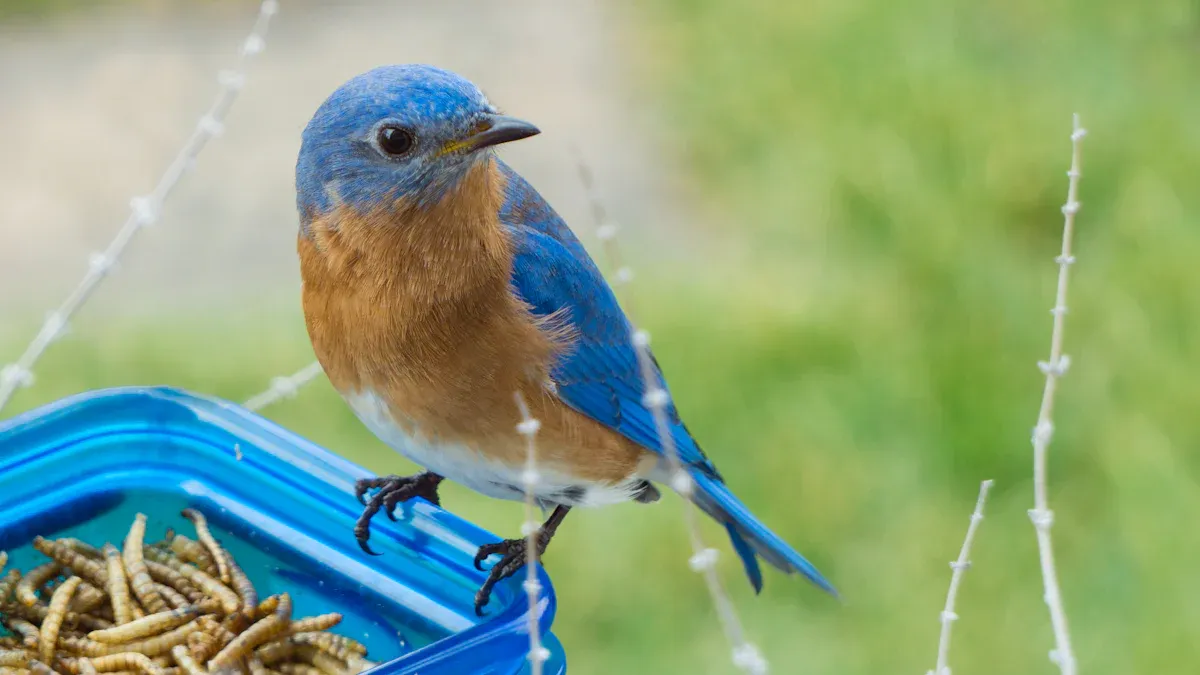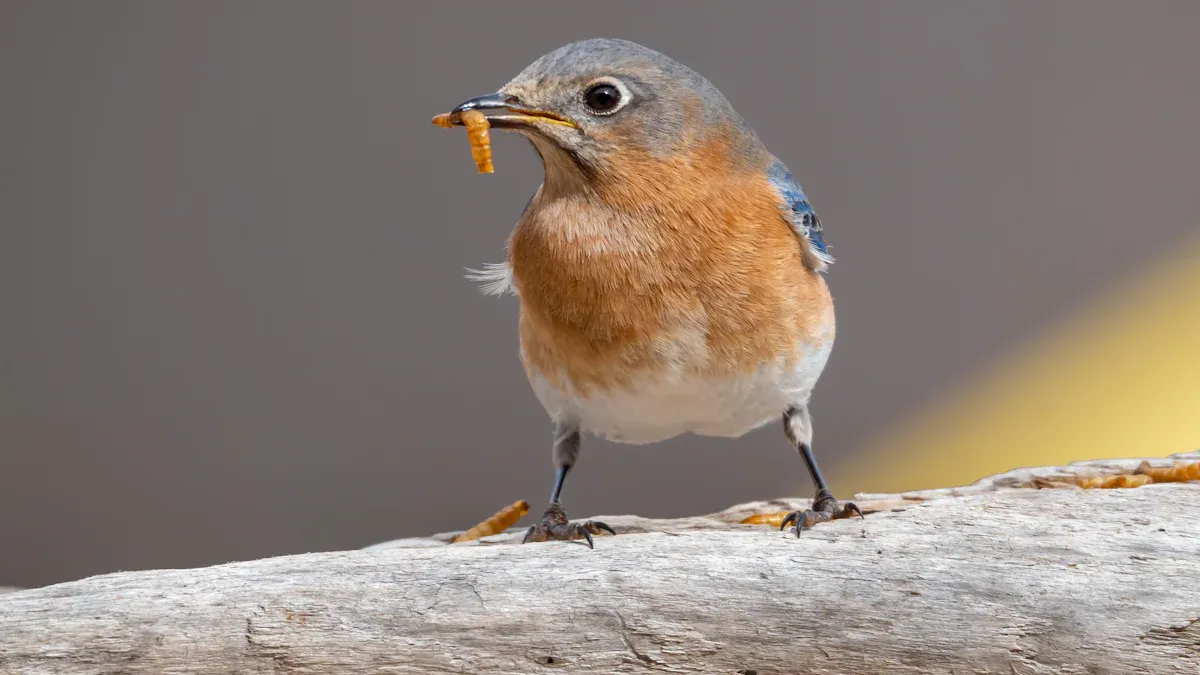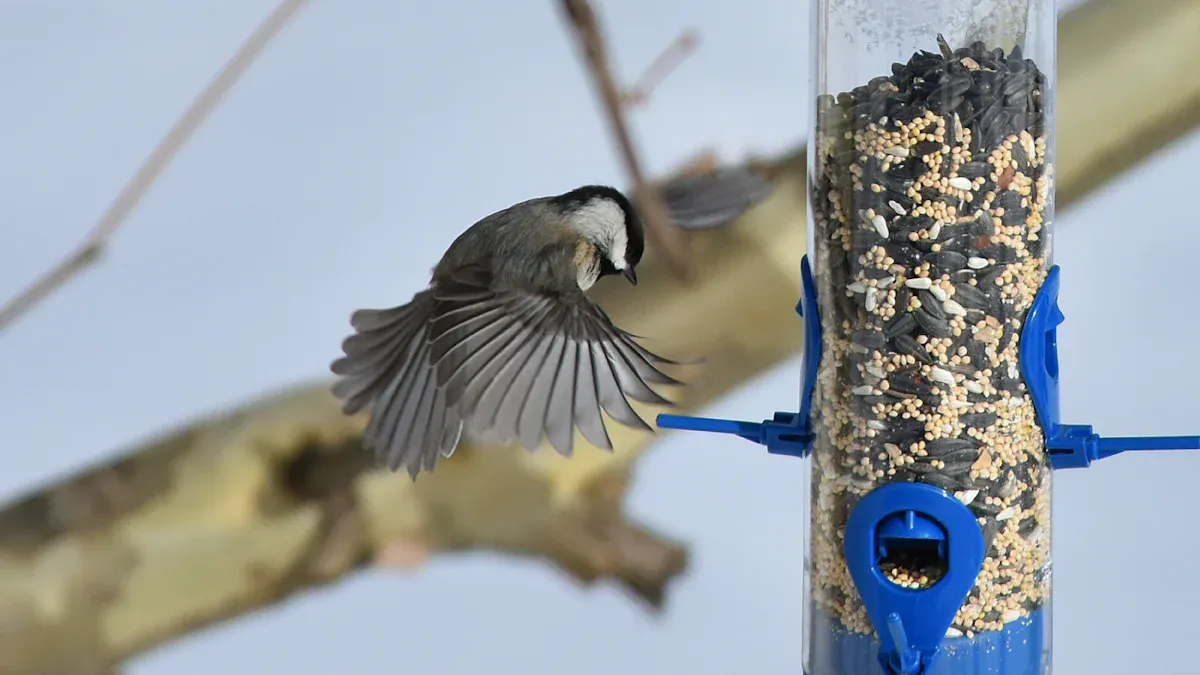
A mealworm feeder for birds is a simple tool that helps backyard bird enthusiasts provide a nutritious treat to their feathered visitors. Mealworms are packed with protein, fat, and essential nutrients, making them an excellent food source. They attract species like bluebirds, robins, and woodpeckers, especially when insects are scarce. Studies show that 96% of North American birds rely on insects at some point, and mealworms can boost chick survival during breeding seasons. With their high protein content, mealworms support bird health and growth, making them a valuable addition to any yard.
Key Takeaways
- Mealworm feeders give birds important nutrients and attract many kinds.
- Pick a feeder that suits the birds near you for better results.
- Clean your feeder often to stop mold and bugs, keeping it safe for birds.
Types of Mealworm Feeders for Birds

Birdwatchers have plenty of options when it comes to choosing a mealworm feeder for birds. Each type has unique features that cater to different bird species and feeding habits. Let’s explore the most popular ones.
Tray feeders
Tray feeders are simple and versatile. They feature a flat, open surface where birds can easily land and feed. These feeders are great for attracting a variety of birds, including ground-feeding species like sparrows and doves. Many birdwatchers prefer tray feeders because they reduce waste by keeping mealworms visible and accessible. However, they may also attract squirrels, so placing them strategically can help.
Dish feeders
Dish feeders are compact and easy to use. They typically consist of a small bowl or dish that holds mealworms securely. These feeders are perfect for smaller birds like bluebirds and chickadees. Some designs even include perches, making it easier for birds to feed comfortably. Dish feeders are also easy to clean, which helps maintain a healthy feeding environment.
Covered feeders
Covered feeders protect mealworms from rain and wind, keeping them fresh and appealing. These feeders often have a roof or dome that shields the food while allowing birds to access it. Covered feeders are especially useful in areas with unpredictable weather. They also help prevent mold, ensuring the mealworms remain safe for birds to eat.
Hanging feeders
Hanging feeders are a popular choice for their convenience and versatility. These feeders can be suspended from tree branches, poles, or hooks, making them easy to place in different parts of your yard. Hanging feeders often come with weather-resistant designs, ensuring durability. They’re ideal for attracting birds like woodpeckers and nuthatches, which enjoy clinging to feeders while they eat.
Tip: To attract specific birds, consider using a mealworm bluebird feeder. These feeders have small entry holes that allow bluebirds to feed without interference from larger birds like starlings.
Choosing the Right Mealworm Feeder for Birds
Consider the bird species in your area
Different birds have unique feeding habits, so it’s important to choose a feeder that suits the species in your yard. For example, bluebirds prefer feeders with small openings that keep larger birds out. Ground-feeding birds like sparrows might enjoy tray feeders, while woodpeckers and nuthatches often prefer hanging feeders. Observing the birds in your area can help you decide which feeder works best.
Tip: Use adjustable domes or small entry holes to limit access to specific birds. This ensures smaller species can feed without interference from larger birds.
Evaluate feeder capacity and design
The size and design of a feeder can make a big difference. A feeder with a larger capacity is ideal if you have a high bird population, as it reduces the need for frequent refills. Look for designs that are easy to clean, like those with removable trays. Clean feeders prevent the spread of diseases and keep mealworms fresh. Additionally, feeders with drainage holes can stop mealworms from drowning during rainy weather.
Here’s a quick guide to helpful features:
- Durable materials like metal or high-quality plastic.
- Accessibility for birds while deterring larger animals.
- Ease of cleaning to maintain a healthy feeding environment.
Look for weather resistance and durability
A good mealworm feeder for birds should withstand harsh weather. Durable materials like metal or weather-resistant plastic ensure the feeder lasts longer. Features like a roof or dome protect mealworms from rain and direct sunlight, keeping them fresh and appealing. This is especially important in areas with unpredictable weather. Strategic placement of the feeder can also help protect it from predators like squirrels or raccoons.
| Feature | Description |
|---|---|
| Durability | Made from materials that withstand weather conditions. |
| Roof | Protects mealworms from rain and direct sunlight. |
| Cleanable Tray | A removable tray that prevents mealworms from escaping and is easy to clean. |
| Opening Size | True 1.5″ to 1.75″ openings to allow access for bluebirds but not larger birds. |
By considering these factors, bird enthusiasts can select a feeder that meets their needs and keeps their feathered friends happy.
Setting Up a Mealworm Feeder for Birds

Where to place the feeder in your yard
The placement of a mealworm feeder can make a big difference in attracting birds. Position the feeder near shrubs or trees to give birds a sense of safety while they feed. Avoid placing it too close to windows to prevent accidental collisions. A spot with partial shade works well, as it keeps the mealworms fresh and prevents overheating.
To keep mealworms from escaping, use a feeder with smooth surfaces like glass or plastic. A platform feeder or a rimmed dish is also effective for containing mealworms. If squirrels or other pests are a concern, consider hanging the feeder on a pole with a baffle to deter them.
Tip: Place the feeder in a location where you can easily observe the birds without disturbing them.
How to fill the feeder with dried mealworms
Filling the feeder is simple but requires a bit of care. Start by adding a small amount of dried mealworms to gauge the birds’ interest. Overfilling can lead to waste or attract pests. Use a clean, dry scoop to transfer the mealworms into the feeder. If you’re using a dish or tray feeder, spread the mealworms evenly to make them more visible to birds.
For an extra treat, soak the dried mealworms in water before placing them in the feeder. This adds hydration, especially during hot summer months. Always ensure the feeder is easy to access for refilling and cleaning.
Tips for keeping mealworms fresh and appealing
Keeping mealworms fresh is key to attracting birds. Protect the feeder from rain by using one with a roof or dome. This prevents the mealworms from becoming soggy or moldy. In hot weather, place the feeder in a shaded area to avoid spoilage. Regularly check the feeder and remove any uneaten mealworms to maintain cleanliness.
To prevent pests, start small and monitor the feeder closely. Learning to manage pests early can save you from bigger problems later. Clean the feeder weekly with warm, soapy water to keep it hygienic and inviting for birds.
Note: A clean and well-maintained mealworm feeder for birds ensures a steady stream of feathered visitors to your yard.
Attracting Birds to Your Mealworm Feeder
Timing your feeding schedule
Timing plays a big role in attracting birds to a mealworm feeder for birds. Birds are most active in the early morning and late afternoon. These times are ideal for placing fresh mealworms in the feeder. Early morning feeding helps birds replenish their energy after a long night, while late afternoon feeding prepares them for the evening. Consistency is key. Birds will return regularly if they know when to expect food. Avoid leaving mealworms out overnight, as this can attract unwanted pests like raccoons or rodents.
Tip: Set a reminder to refill the feeder at the same time each day to establish a routine for your feathered visitors.
Offering additional food sources
Mealworms are a great start, but adding variety can attract more bird species. Seeds and fruits are excellent options to complement mealworms. Caterpillars are another high-protein choice that birds love. They also provide essential nutrients like calcium and potassium. Offering a mix of food sources ensures a balanced diet for the birds and keeps them coming back. Place seeds or fruits in a separate feeder or scatter them near the mealworm feeder to create a buffet-like experience.
- Suggestions for additional food sources:
- Seeds like sunflower or millet.
- Fruits such as apples or berries.
- Caterpillars for extra protein and nutrients.
Creating a bird-friendly environment
A welcoming yard encourages birds to visit and stay. Plant native shrubs and trees to provide shelter and nesting spots. Adding a birdbath offers a water source for drinking and bathing. Keep the area around the feeder clean to prevent pests and diseases. Birds feel safer in quiet spaces, so choose a location away from heavy foot traffic or loud noises. A well-maintained yard with plenty of natural cover will make birds feel at home.
Note: A bird-friendly environment not only attracts birds but also supports their overall health and well-being.
Maintaining Your Mealworm Feeder for Birds
How to clean the feeder regularly
Keeping a mealworm feeder clean is essential for the health of visiting birds. Regular cleaning prevents mold, pests, and bacteria from building up. Start by removing any leftover mealworms or food debris every few days. If wet food is used, replace it frequently to avoid spoilage. Dry food can stay longer but should still be refreshed weekly or biweekly.
To maintain hygiene, remove dead mealworms, beetles, or molted skins every few weeks. These remains can attract pests or cause contamination. Additionally, clean out frass (mealworm waste) every three to four weeks unless the feeder is emptied more quickly. A clean feeder ensures birds have access to safe, nutritious food.
Tip: Use warm, soapy water to wash the feeder and let it dry completely before refilling.
Preventing mold and pests
Mold and pests can ruin a mealworm feeder if not managed properly. To prevent mold, avoid over-moistening food and replace any moldy items immediately. If mold appears, transfer mealworms to a clean container and disinfect the feeder with natural solutions like vinegar or tea tree oil. These are safe and effective for cleaning.
Pests like ants or rodents can also become a problem. Regular cleaning is the first line of defense. For added protection, consider placing the feeder on a pole with a baffle or using pest-resistant designs. Maintaining proper humidity levels, such as using a damp paper towel for moisture control, can also help keep the feeder in good condition.
Refilling the feeder efficiently
Refilling a mealworm feeder doesn’t have to be time-consuming. Start by adding small amounts of mealworms to avoid waste. Monitor how quickly birds consume the food and adjust the quantity as needed. For dried mealworms, soaking them in water before refilling can provide extra hydration, especially during hot weather.
A well-stocked feeder benefits both birds and birdwatchers. It ensures birds receive consistent nutrition while reducing the effort needed for maintenance. Keeping the feeder clean and organized makes refilling quicker and more efficient.
Note: A clean and well-maintained feeder not only attracts more birds but also creates a healthier environment for them to thrive.
Using a mealworm feeder for birds offers countless benefits. It provides essential nutrition, attracts a variety of bird species, and creates opportunities to observe their fascinating behaviors. Beginners should focus on feeder design, temperature control, and access management to ensure success. Watching birds interact with feeders not only entertains but also promotes mental well-being. Research shows that birdwatching can reduce stress and anxiety, making it a rewarding hobby for all ages. Why not give it a try? A simple feeder could transform your yard into a lively bird haven.
Fun Fact: Over 43% of U.S. households enjoy birding, proving its widespread appeal and positive impact on mental health.
FAQ
What are the benefits of feeding birds dried mealworms?
Dried mealworms provide protein, fats, and fiber, which support bird health year-round. Soaking them in water adds hydration, especially during hot summer months. 🐦💧
How often should a mealworm feeder be refilled?
Refill the feeder daily or as needed. Monitor how quickly birds consume the mealworms to avoid waste and keep the food fresh.
Can mealworms attract unwanted pests?
Yes, mealworms can attract pests like ants or rodents. Use pest-resistant feeders, clean regularly, and avoid overfilling to minimize the risk.
Tip: Place the feeder on a pole with a baffle to deter pests effectively.


